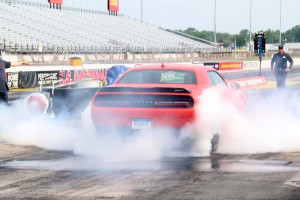
With 840 horsepower at your feet, it should be easy to rile up the Demon into a smoke-inducing frenzy.
With 840 horsepower ready to roar at the slightest twitch of my right foot, one might think it’d be easy to burn rubber. But as I pull up to the box on the Lucas Oil Speedway, it seems like I’ve forgotten how to get my arms, legs and brain to sync up. There’s a short squeal and then … nothing.
Well, not quite nothing. I’ve managed to disengage the Car’s Launch Control. The Christmas Tree has turned green. My cherry red Dodge Demon has stopped cold. My co-pilot is nothing if not patient, admitting he’s new to drag racing himself and blew a couple starts before he figured it all out.
Another attempt and this time the tires kick up enough smoke the track could be declared an EPA hazard site. Of course, that’s just to get the rubber warm. I pull into the box, engage Launch Control, simultaneously step on the gas and brake, and wait for the green again. As my left foot comes off the pedal, my right foot this time slams the throttle to the floor, delivering enough G force for my vision to tunnel.
“You got air that time,” my co-pilot says, as we soar down towards the quarter mile in what likely would have been under 10 seconds if the timer was on. Whatever the real number, I can smell the raw adrenaline oozing out of every pore. For the first time in my life I truly understand the thrill of drag racing.
Of course, I’m not the first one to find dharma on the dragstrip. And 3,300 lucky buyers will have the chance to experience it on their own once the new Dodge Challenger Hellcat SRT Demon comes to market. Considering it takes almost as long to complete that mouthful as it does to complete the quarter-mile, we’ll stick to Dodge Demon going forward.
(Click Here for more on the New York Auto Show debut of the Dodge Demon.)
Dodge is no stranger to the dragstrip, of course. It introduced a 10,000 horsepower Charger R/T Funny Car a few years ago. But few of us will ever experience anything like that, except on TV. More than a few customers have been letting loose with the 707 hp Dodge Hellcat, which is offered in both Charger sedan and Challenger coupe trims. But, unless you’ve got a couple million dollars to spare for the likes of a Bugatti Chiron or Koenigsegg Agera, the new Demon takes you into uncharted territory as the most powerful V-8-powered automobile ever to roll off a factory line.
Making that 840 hp and 808 pound-feet of torque, it’ll get you from 0 to 60 in a mere 2.3 seconds, with 1.3 Gs pressing you firmly into the car’s supportive sports seat – or seats, as you can opt for a single seat or pay another $1 for a passenger seat and yet another buck for a back seat if you need to get your kids to daycare in a hurry.
Since the Demon made its debut and the official figures came out during the New York International Auto Show last April there’s been an ongoing debate over whether the Dodge coupe truly is the world’s fastest car from 0 to 60, by the way. Some have suggested the Tesla Model S P100d with Ludicrous Mode engaged does the Demon in, if only by the hundredths of a second.
We’ve not run our own tests but we’ll point out that Tesla’s electric drive system can only manage a few of those runs before it overheats and drains the battery. The Demon, on the other hand, can make flat-out quarter-mile runs over and over and over and over, as we realized watching a long morning of media drives. Better yet, Unless you make any significant modifications, your Demon will have a 3-year/36,000-mile warranty.
There are some modifications to be made if you are looking to put your Demon on the track, but a number of them come as part of the Demon Crate that also will cost you a whole dollar. They include a higher-performance chip to maximize the engine’s performance. And you get narrower front tires, all the work on the raceway being done by those massive and sticky rear 315/40R15 Nitto design rubber shoes, the first-ever street-legal cheaters – just short of full slicks.
To qualify for NHRA racing, meanwhile, you’ll need a rollcage and a 5-point harness. Not a bad idea considering you’ll blow through the traps in 9.65 seconds, topping out at around 140 mph at the quarter-mile mark.
What does it take to get there? Despite what some expected, this isn’t just a tuned-up Hellcat, but “a whole new engine,” explains Dodge brand chief Tim Kuniskis. Well, nearly all-new, WITH 62% of the 6.2-liter powertrain, by dollar value, strengthened, updated or completely replaced.
The supercharger is bigger – going from 2.4 to 2.7 liters. That’s big enough to suck out every molecule of air from Demon’s cabin within the first 800 feet after a dragstrip launch.. There’s a new Chill Air system that actually hijacks the standard air conditioning system to cool intake air by as much as 45 degrees on a hot day, cooler, denser air translating into significantly better performance.
Virtually every element of the Demon has been hardened, from the crankshaft and pistons to the driveline and axles. There’s some sophisticated electronics controlling the entire system to make sure as much power reaches the pavement as possible. Smoky tires make great photos but they lose races.
The steel prop shaft is 15% stronger than Hellcat’s The eight-speed ZF gearbox has been upgraded. And it now is the first production car offered with a TransBrake, one of two trick ways to maximize take-off. There’s the more familiar Launch Control, of course. But the Dodge engineering team has given Demon a Torque Reserve system that pre-fills the supercharger to build boost. The TransBrake locks the transmission output shaft letting you lock the transmission output shaft and essentially launching the car with just the paddle shifters and your right foot.
Of course, you start off by using the Line Lock feature to spin the wheels to warm them up – making them stickier and creating a cloud of intimidating smoke. When you take off, the TransBrake system automatically adjusts spark and, more broadly, ensures you get just the right amount of torque to ensure the tires lock up to the pavement.
(For more details on how the Dodge Demon turns out 840 hp, Click Here.)
Trying to learn and then operate Line Lock, TransBrake and Launch Control can be intimating, as we and other journalists on the trip soon learned. But once you figured out how to coordinate hands and feet, the rewards were impressive, the Demon launching off the line with head-snapping acceleration guaranteed to either put a smile on your face or send you looking for the barf bag.
Speed is one thing, but the Demon seemed confidently sure-footed as it raced the quarter, with only a modest amount of shake at full acceleration.
We’d have liked to have some real time on public roads driving the Demon. We were limited to some modest loops around the Lucas Oil Speedway due to the massive storm that swept through Indy on the first of our two days of driving. A planned morning on the Indianapolis Motor Speedway was washed out. And the the dragstrip was, by mid-afternoon, under a foot of water. Kudos to the crew that worked overnight to dry things off for our second day.
What we can say about using the Demon as a daily driver is that you’ll certainly want to save the narrow front racing tires for the track. You don’t have to worry about swapping out the higher-performance chip, however, as you can set it for street mode with the touch of a button. (And by sticking with normal premium unleaded, rather than racing fuel.)
Dodge engineers make no bones about the fact that the only slightly less awe-inspiring Hellcat is the better car for everyday driving – something we can confirm after spending about 500 miles behind the wheel of the 707 hp Charger version after finishing up in Indianapolis. The Demon has clearly been set up primarily for straight-line runs, whether on the street or dragstrip. That said, it still appears to be a lot more maneuverable than the classic street rods from the “Golden Age” of muscle cars.
As to what it will cost you? The 2018 Dodge Challenger SRT Demon will start at $84,995 – or about $20,000 more than the Challenger Hellcat. That figure does include both delivery charges and the federal gas guzzler tax. For $1 each you can order a front passenger seat, a rear seat, and a trunk carpet kit. Dodge isn’t directly offering the rollcage or 5-point harness but there’ll be plenty of aftermarket vendors to turn to.
(Learn more about Dodge extended warranty plans.)
Dodge plans to build just 3,300 Demons, Kuniskis explaining, “It’s not about selling lots of cars. It’s about getting every Dodge owner and possible customer to look at this and want to be part of the Dodge brand.”
As the only factory-built muscle car capable of launching wheelies, the Dodge Demon is already getting the brand plenty of attention.
(For more on Demon pricing, Click Here.)

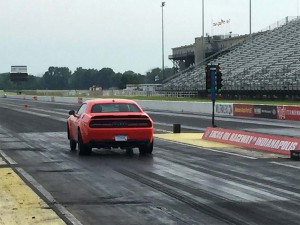
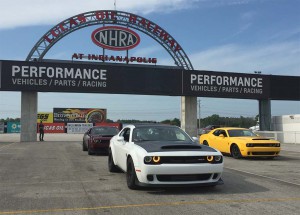
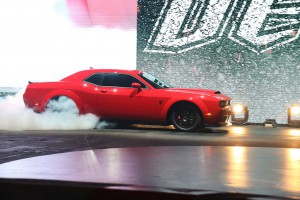
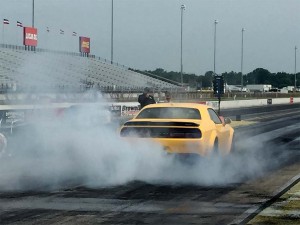
I question “the first ever street legal cheaters”. I had a pair of “cheater slicks” on the back of my ’64 Mercury Maurader. They came from a full service tire dealer, had enough tread groove to make them street legal in the eyes of the law, though they were recaps, legal at the time, and not as sticky as today’s tires.
First ever by a factory. You can find plenty on the aftermarket. And whether those you used would have been acceptable coming from a factory I cannot say.
Paul E.